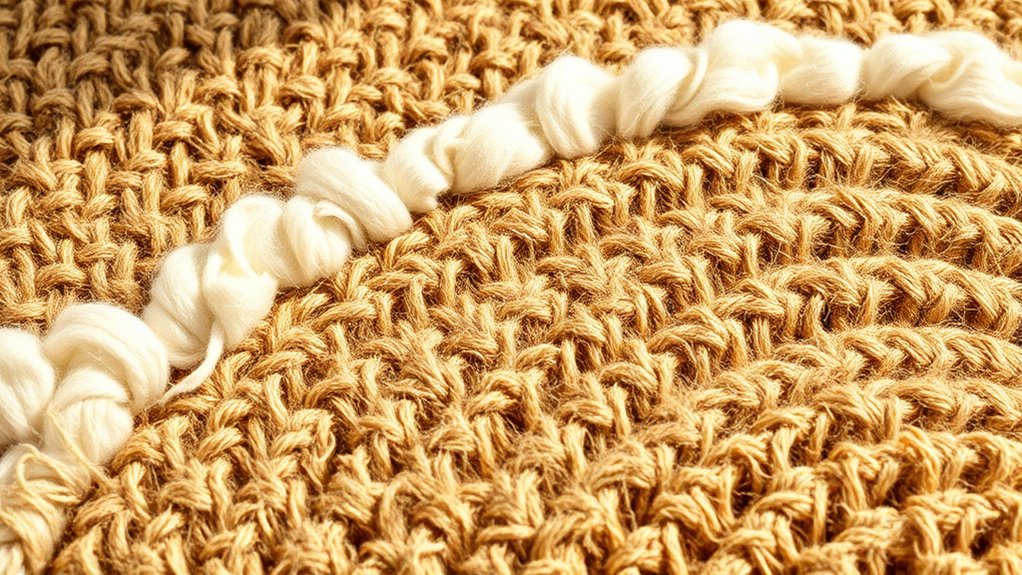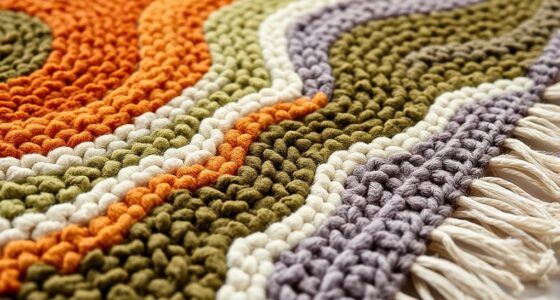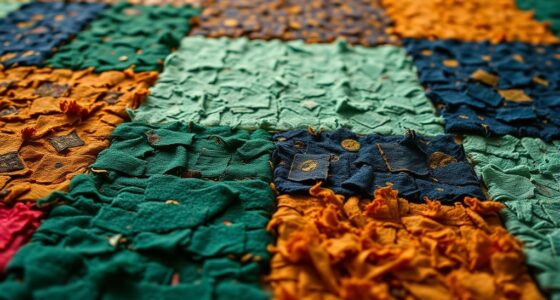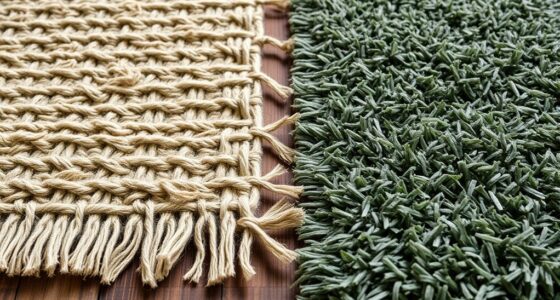Eco-friendly rug backings provide a safer and more sustainable alternative to synthetic latex by using natural adhesives, recycled materials, and biodegradable options. These backings help reduce your home’s chemical exposure and lessen environmental impact through materials like recycled rubber or plastics and plant-based adhesives. They also meet safety standards for fire hazards, ensuring durability without toxic chemicals. Keep exploring to discover how these eco-conscious choices can enhance your home and support sustainability.
Key Takeaways
- Eco-friendly rug backings often use natural adhesives derived from plant-based or biodegradable sources, eliminating harmful VOC emissions.
- Recycled materials like rubber tires and plastics are incorporated into backings, reducing waste and conserving natural resources.
- These alternatives meet safety standards, ensuring durability and fire safety without relying on synthetic latex.
- Choosing eco-friendly backings promotes healthier indoor air quality and supports sustainable manufacturing practices.
- They offer a biodegradable, renewable option that minimizes environmental impact compared to traditional synthetic latex backings.
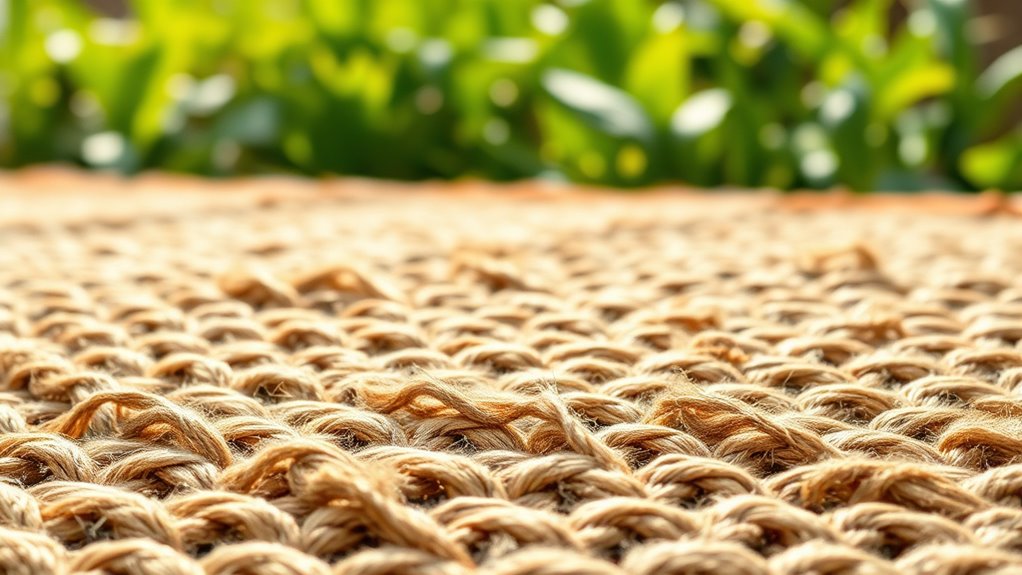
As consumers become more environmentally conscious, eco-friendly rug backings have gained popularity as a sustainable alternative to traditional materials. You’re now more likely to seek options that reduce your ecological footprint, and choosing eco-friendly rug backings is a smart step in that direction. These alternatives often avoid synthetic latex, which is common in conventional rug backings but can contain chemicals that are harmful to the environment and indoor air quality. Instead, you can opt for materials that are safer, renewable, and biodegradable, making your home not only stylish but also more sustainable.
One of the key features of eco-friendly rug backings is the use of natural adhesives. These adhesives are derived from plant-based sources or other biodegradable substances, which means they do not emit volatile organic compounds (VOCs) or other harmful chemicals. When you choose rugs with natural adhesives, you’re reducing your exposure to toxins, and you’re also supporting practices that minimize environmental impact. Natural adhesives provide strong adhesion, ensuring your rug stays in place without compromising on safety or sustainability. This choice reflects a growing awareness of the importance of chemical-free products in everyday living spaces.
Natural adhesives in eco-friendly rug backings reduce toxins and ensure strong, safe adhesion for a healthier home environment.
Recycled materials are another cornerstone of eco-friendly rug backings. Many manufacturers now incorporate recycled fibers, plastics, or rubber into their backing products. For example, you might find rug backings made from recycled rubber tires or repurposed plastics, which helps divert waste from landfills. Using recycled materials reduces the demand for virgin resources and lowers the environmental footprint associated with manufacturing new products. When you select a rug with a backing made from recycled materials, you’re actively contributing to waste reduction and resource conservation.
Additionally, selecting rug backings that comply with wood stove safety standards ensures that your home remains safe and free from fire hazards. Combining natural adhesives with recycled materials creates a truly eco-conscious product that aligns with your values. These backings tend to be durable, effective at grip, and free from toxic chemicals, making them a responsible choice for your home. Furthermore, they often undergo rigorous testing to ensure safety and durability, so you don’t have to compromise on quality. By opting for these eco-friendly options, you’re supporting sustainable manufacturing practices, encouraging innovation, and helping protect the planet for future generations.
Frequently Asked Questions
How Do Eco-Friendly Rug Backings Compare in Durability?
Eco-friendly rug backings generally match or even surpass synthetic latex in durability because of their high-quality material composition, like natural rubber or plant-based adhesives. You’ll find they withstand wear and tear well, making them reliable over time. Plus, their lower environmental impact means you’re choosing a sustainable option without sacrificing longevity. So, you get a durable rug backing that’s better for the planet, ensuring your rug stays secure and vibrant longer.
Are Natural Backings More Affordable Than Synthetic Latex?
Natural backings are generally more affordable than synthetic latex, mainly due to lower material costs and easier availability. You’ll find that the cost comparison favors natural options because they’re often sourced locally and require fewer manufacturing steps. While synthetic latex can be more consistent and durable, natural materials tend to be more budget-friendly, especially when considering eco-conscious choices. So, if affordability matters, natural backings are a smart, cost-effective alternative.
Can Eco-Friendly Backings Be Recycled or Reused?
Yes, eco-friendly rug backings can often be recycled or reused, especially if they’re made from natural or biodegradable materials. You can participate in recycling programs that accept these backings, helping reduce waste. Additionally, many natural backings have reuse potential, such as repurposing them for craft projects or other household uses. By choosing eco-friendly options, you support sustainability and help lessen environmental impact through proper recycling and reuse.
Do Eco-Friendly Rug Backings Emit Fewer VOCS?
Yes, eco-friendly rug backings emit fewer VOCs, helping improve indoor air quality. You’ll notice less chemical smell and reduced VOC emissions, which can benefit your respiratory health and overall environment. These alternatives use natural, non-toxic materials that release fewer harmful compounds over time. By choosing eco-friendly backings, you actively promote healthier indoor spaces, making your home safer and more comfortable for everyone.
How Do Eco-Friendly Options Impact Overall Rug Lifespan?
Eco-friendly rug backings typically enhance overall rug lifespan by using durable, natural materials that resist wear and tear. This has positive environmental benefits, reducing waste and the need for frequent replacements. Your consumer perceptions also improve, as eco-conscious choices reflect care for sustainability. Overall, choosing eco-friendly backings can make your rug last longer, supporting both environmental health and your satisfaction with a durable, high-quality product.
Conclusion
Choosing eco-friendly rug backings helps protect the environment and your health. Alternatives like natural latex, wool, or plant-based adhesives reduce reliance on synthetic materials. Did you know that using sustainable backing options can cut down indoor VOC emissions by up to 50%? By making this switch, you’re not only supporting eco-conscious practices but also creating a healthier living space. Every small change counts—so consider greener backing options for your rugs today.
